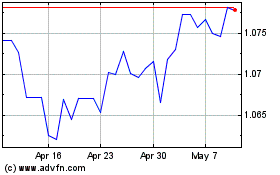Euro Higher As Eurozone CPI Matches Forecasts
May 31 2016 - 2:42AM
RTTF2
The euro was higher against most major opponents in European
deals on Tuesday, after Eurozone consumer prices logged only a
marginal fall as expected in May, ahead of the European Central
decision due Thursday.
Flash estimate published by Eurostat showed that consumer prices
dropped 0.1 percent from last year as expected by economists after
easing 0.2 percent in April. This was the second consecutive
decline in prices.
Core inflation that excludes energy, food, alcohol and tobacco
slowed slightly to 0.8 percent in May from 0.7 percent a month
ago.
Energy prices slid 8.1 percent annually but slower than the
April's 8.7 percent fall. The annual increase in food, alcohol and
tobacco held steady at 0.8 percent.
Separate data from the same agency showed that the Eurozone
jobless rate remained stable at the highest level in more than four
years in April.
The unemployment rate came in at 10.2 percent in April, the same
rate as seen in March, and in line with expectations. This was the
lowest rate recorded in the euro area since August 2011
The European markets are trading in a negative territory, amid
caution ahead of ECB rate setting meeting and OPEC gathering due
this week.
Although the ECB is expected to keep policy unchanged, traders
focus on more hints about the impact of latest stimulus measures on
the economy at its interest rate decision in Vienna.
The euro showed mixed trading against its major rivals in Asian
trading. While the euro declined against the pound and the
greenback, it advanced against the yen. Against the franc, it held
steady.
The 19-nation currency rose to 1.1151 against the greenback,
heading closer to pierce its early 4-day high of 1.1155. The next
possible resistance for the euro-greenback pair is likely seen
around the 1.13 mark.
Following a weekly decline to 0.7573 against the pound at 11:45
pm ET, the euro climbed to a 4-day high of 0.7642. On the upside,
the euro may find resistance around the 0.78 area.
The euro bounced off to 123.86 against the Japanese yen, off its
early low of 123.40. The euro may violate its early Asian session's
2-week high of 124.14. If the euro rises further, 125.00 is likely
seen as its next resistance level.
Data from the Ministry of Land, Infrastructure, Transport and
Tourism showed that Japan's housing starts expanded at the fastest
pace in 10 months in April.
Housing starts grew by more-than-expected 9 percent year-on-year
in April, the biggest growth since June 2015, when it climbed 16.3
percent. Economists had expected 4.1 percent growth after posting
8.4 percent increase in March.
Reversing from an early low of 1.4499 versus the loonie, the
euro edged up to 1.4563. The euro is seen finding resistance around
the 1.48 zone.
On the flip side, the euro declined to a new 2-week low of
1.1029 versus the Swiss franc and held steady thereafter. At
Monday's close, the pair was valued at 1.1048. On the downside,
1.09 is possibly seen as the next support level for the euro-franc
pair.
Looking ahead, Canada GDP for March, U.S. personal income and
spending data for April, S&P/Case-Shiller home price index for
March, Chicago PMI for May and consumer confidence index for May
are slated for release in the New York session.
Euro vs US Dollar (FX:EURUSD)
Forex Chart
From Mar 2024 to Apr 2024

Euro vs US Dollar (FX:EURUSD)
Forex Chart
From Apr 2023 to Apr 2024
